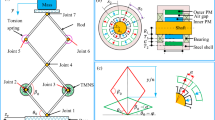Abstract
A simple approach for the suppression of the tremor associated with Parkinson's disease is presented. The proposed system is a tuned vibration absorber (TVA), which has been very effective in the suppression of vibrations in an experimental model of the human arm with two degrees of freedom. Theoretical and numerical methods were used to study the behaviour of the arm model and to develop an effective tremor reduction approach. Based on these studies, a vibration absorber was designed, tested numerically and fabricated for experimental testing. Expermental investigations indicated that optimum control performance was related to the position of the controller and the excitation frequency. With a distance of 160 mm from the end of forearm, the TVA was found to have the best performance, and, for different tremor frequencies, the vibration of the experimental model was reduced by more than 80%.
Similar content being viewed by others
References
Arnold, A., andRosen, M. (1993): ‘Evaluation of a controlled-energy-dissipation orthosis for tremor suppression’,J. Electromyogr. and Kinesiol.,3, pp. 131–148
Cannon, S. C., andZahalak, G. I. (1982): ‘The mechanical behaviour of active human skeletal muscle in small oscillations’,J. Biomech.,15, pp. 111–122
Cnockaert, J. C., Lensel, C., andPertuzon, E. (1975): ‘Relative contribution of individual muscles to the isometric contraction of a muscular group’,J. Biomech.,8, pp. 191–197
Corradini, M. L., Gntilucci, M., Leo, T., andRizolatti, G. (1992): ‘Motor control of voluntary arm movement’,Biol. Cybern.,57, pp. 347–360
Flanagan, J. R., Feldman, A. G. andOstry, D. J. (1992): ‘Equilibrium trajectories underlying rapid target-directed arm movements’,Tutor. Motor Behav., pp. 661–675
Griffin, G. J. (1990): ‘Handbook of human vibration’ (Academic Press, 1990), p. 182
Hall, W. D. (1996): ‘Hand-held gyroscopic device’,US Patent 5562707
Inman, D.J. (1996): ‘Engineering vibration’ (Prentice Hall, 1996)
Jackson, K. M., andJoseph, J. (1978): ‘A mathematical model of arm swing during human locomotion’,J. Biomech.,11, pp. 277–289
Karnopp, D. (1995): ‘Active and semi-active vibration isolation’,Special 50th Anniversary Design Issue,117, pp. 177–185
Lan, N. (1997): ‘Analysis of an optimal control model of multi-joint arm movements’,Biol. Cybern.,76, pp. 107–117
Lemay, M., andCrago, P. (1996): ‘A dynamic model for simulating movements of the elbow, forearm, and wrist’,J. Biomech.,29, pp. 1319–1330
Li, L. (2000): ‘Modelling and tremor suppression of human arm with Parkinson's disease’, MSc thesis, (Department of Mechancial Engineering, University of Waterloo, Ontario, Canada
Maia, N. M. M., andSilva, J. M. M. (1997): ‘Theoretical and experimental modal analysis’ (Research Studies Press Ltd, Somerset, UK, 1997)
Nagaya, K., Kurusu, A., Ikai, S., andShitani, Y. (1999): ‘Vibration control of a structure by using a tunable and an optimal vibration absorber under auto-tuning control’,J. Sound Vibrat.,228, pp. 773–792
Parkinson, J. (1817): ‘An essay on the shaking palsy’ (Sherwood, Needly and Jones, London, 1817)
Prochazka, A., Elek, J., andJavidan, M. (1992): ‘Attenuation of pathological tremors by functional electrical stimulation I: method’,Ann. Biomech. Eng.,20, pp. 204–205
Raikova, R. (1992): ‘A general approach for modeling and mathematical investigation of the human upper limb’,J. Biomech.,25, pp. 857–867
Repperger, D. (1989): ‘Accurate hand movement assistance’,US Patent 4842607
Rosen, M. (1986): ‘Tremor suppressing hand controls’,US Patent 4689449
Seto, K., andTakita, Y. (1984): ‘Vibration control in multi-degree-freedom systems, Report 1: On the design of dynamic absorbers’,Trans. Jpn Soc. Mech. Eng.,50, p. 458
Sun, J. Q., Jolly, M. R., andMorris, M. A. (1995): ‘Passive, adaptive and active tuned vibration absorbers—A survey.’,Trans. ASME,117, pp. 234–240
Williams, J. H. (1996): ‘Fundamentals of applied dynamics’ (John Willey & Sons Inc., 1996)
Yang, Y., Yahia, L., andFeldman, A. G. (1993): ‘A versatile dynamic model of human arm’,Adv. Bioeng. ASME,26, pp. 36–47
Author information
Authors and Affiliations
Rights and permissions
About this article
Cite this article
Hashemi, S.M., Golnaraghi, M.F. & Patla, A.E. Tuned vibration absorber for suppression of rest tremor in Parkinson's disease. Med. Biol. Eng. Comput. 42, 61–70 (2004). https://doi.org/10.1007/BF02351012
Received:
Accepted:
Issue Date:
DOI: https://doi.org/10.1007/BF02351012




